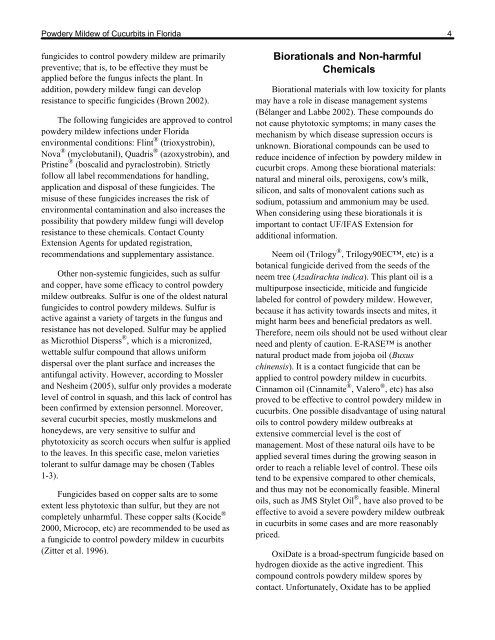Powdery Mildew of Cucurbits in Florida - Orange County Extension ...
Powdery Mildew of Cucurbits in Florida - Orange County Extension ...
Powdery Mildew of Cucurbits in Florida - Orange County Extension ...
Create successful ePaper yourself
Turn your PDF publications into a flip-book with our unique Google optimized e-Paper software.
<strong>Powdery</strong> <strong>Mildew</strong> <strong>of</strong> <strong>Cucurbits</strong> <strong>in</strong> <strong>Florida</strong> 4<br />
fungicides to control powdery mildew are primarily<br />
preventive; that is, to be effective they must be<br />
applied before the fungus <strong>in</strong>fects the plant. In<br />
addition, powdery mildew fungi can develop<br />
resistance to specific fungicides (Brown 2002).<br />
The follow<strong>in</strong>g fungicides are approved to control<br />
powdery mildew <strong>in</strong>fections under <strong>Florida</strong><br />
environmental conditions: Fl<strong>in</strong>t ® (trioxystrob<strong>in</strong>),<br />
Nova ® (myclobutanil), Quadris ® (azoxystrob<strong>in</strong>), and<br />
Prist<strong>in</strong>e ® (boscalid and pyraclostrob<strong>in</strong>). Strictly<br />
follow all label recommendations for handl<strong>in</strong>g,<br />
application and disposal <strong>of</strong> these fungicides. The<br />
misuse <strong>of</strong> these fungicides <strong>in</strong>creases the risk <strong>of</strong><br />
environmental contam<strong>in</strong>ation and also <strong>in</strong>creases the<br />
possibility that powdery mildew fungi will develop<br />
resistance to these chemicals. Contact <strong>County</strong><br />
<strong>Extension</strong> Agents for updated registration,<br />
recommendations and supplementary assistance.<br />
Other non-systemic fungicides, such as sulfur<br />
and copper, have some efficacy to control powdery<br />
mildew outbreaks. Sulfur is one <strong>of</strong> the oldest natural<br />
fungicides to control powdery mildews. Sulfur is<br />
active aga<strong>in</strong>st a variety <strong>of</strong> targets <strong>in</strong> the fungus and<br />
resistance has not developed. Sulfur may be applied<br />
as Microthiol Disperss ® , which is a micronized,<br />
wettable sulfur compound that allows uniform<br />
dispersal over the plant surface and <strong>in</strong>creases the<br />
antifungal activity. However, accord<strong>in</strong>g to Mossler<br />
and Nesheim (2005), sulfur only provides a moderate<br />
level <strong>of</strong> control <strong>in</strong> squash, and this lack <strong>of</strong> control has<br />
been confirmed by extension personnel. Moreover,<br />
several cucurbit species, mostly muskmelons and<br />
honeydews, are very sensitive to sulfur and<br />
phytotoxicity as scorch occurs when sulfur is applied<br />
to the leaves. In this specific case, melon varieties<br />
tolerant to sulfur damage may be chosen (Tables<br />
1-3).<br />
Fungicides based on copper salts are to some<br />
extent less phytotoxic than sulfur, but they are not<br />
completely unharmful. These copper salts (Kocide ®<br />
2000, Microcop, etc) are recommended to be used as<br />
a fungicide to control powdery mildew <strong>in</strong> cucurbits<br />
(Zitter et al. 1996).<br />
Biorationals and Non-harmful<br />
Chemicals<br />
Biorational materials with low toxicity for plants<br />
may have a role <strong>in</strong> disease management systems<br />
(Bélanger and Labbe 2002). These compounds do<br />
not cause phytotoxic symptoms; <strong>in</strong> many cases the<br />
mechanism by which disease supression occurs is<br />
unknown. Biorational compounds can be used to<br />
reduce <strong>in</strong>cidence <strong>of</strong> <strong>in</strong>fection by powdery mildew <strong>in</strong><br />
cucurbit crops. Among these biorational materials:<br />
natural and m<strong>in</strong>eral oils, peroxigens, cow's milk,<br />
silicon, and salts <strong>of</strong> monovalent cations such as<br />
sodium, potassium and ammonium may be used.<br />
When consider<strong>in</strong>g us<strong>in</strong>g these biorationals it is<br />
important to contact UF/IFAS <strong>Extension</strong> for<br />
additional <strong>in</strong>formation.<br />
Neem oil (Trilogy ® , Trilogy90EC, etc) is a<br />
botanical fungicide derived from the seeds <strong>of</strong> the<br />
neem tree (Azadirachta <strong>in</strong>dica). This plant oil is a<br />
multipurpose <strong>in</strong>secticide, miticide and fungicide<br />
labeled for control <strong>of</strong> powdery mildew. However,<br />
because it has activity towards <strong>in</strong>sects and mites, it<br />
might harm bees and beneficial predators as well.<br />
Therefore, neem oils should not be used without clear<br />
need and plenty <strong>of</strong> caution. E-RASE is another<br />
natural product made from jojoba oil (Buxus<br />
ch<strong>in</strong>ensis). It is a contact fungicide that can be<br />
applied to control powdery mildew <strong>in</strong> cucurbits.<br />
C<strong>in</strong>namon oil (C<strong>in</strong>namite ® , Valero ® , etc) has also<br />
proved to be effective to control powdery mildew <strong>in</strong><br />
cucurbits. One possible disadvantage <strong>of</strong> us<strong>in</strong>g natural<br />
oils to control powdery mildew outbreaks at<br />
extensive commercial level is the cost <strong>of</strong><br />
management. Most <strong>of</strong> these natural oils have to be<br />
applied several times dur<strong>in</strong>g the grow<strong>in</strong>g season <strong>in</strong><br />
order to reach a reliable level <strong>of</strong> control. These oils<br />
tend to be expensive compared to other chemicals,<br />
and thus may not be economically feasible. M<strong>in</strong>eral<br />
oils, such as JMS Stylet Oil ® , have also proved to be<br />
effective to avoid a severe powdery mildew outbreak<br />
<strong>in</strong> cucurbits <strong>in</strong> some cases and are more reasonably<br />
priced.<br />
OxiDate is a broad-spectrum fungicide based on<br />
hydrogen dioxide as the active <strong>in</strong>gredient. This<br />
compound controls powdery mildew spores by<br />
contact. Unfortunately, Oxidate has to be applied
















